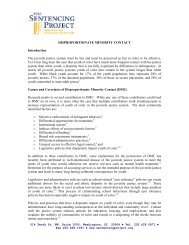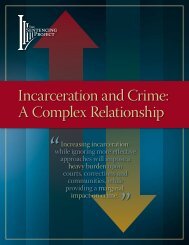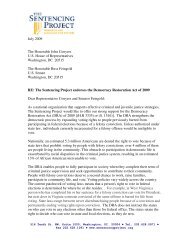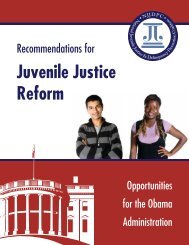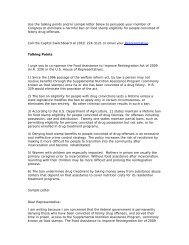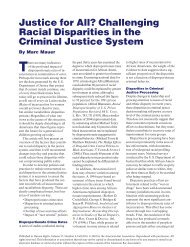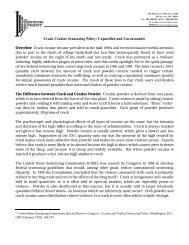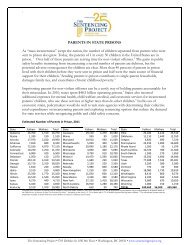The State of Sentencing 2008 - The Sentencing Project
The State of Sentencing 2008 - The Sentencing Project
The State of Sentencing 2008 - The Sentencing Project
Create successful ePaper yourself
Turn your PDF publications into a flip-book with our unique Google optimized e-Paper software.
<strong>The</strong> <strong>State</strong> <strong>of</strong> <strong>Sentencing</strong> <strong>2008</strong><br />
Developments in Policy and Practice<br />
Ryan S. King<br />
February 2009
For further information:<br />
<strong>The</strong> <strong>Sentencing</strong> <strong>Project</strong><br />
514 Tenth St. NW<br />
Suite 1000<br />
Washington, D.C. 20004<br />
(202) 628-0871<br />
www.sentencingproject.org<br />
This report was written by Ryan S. King, Policy Analyst, <strong>of</strong> <strong>The</strong><br />
<strong>Sentencing</strong> <strong>Project</strong>, with research assistance from Laura Brinkman<br />
and Sarah Schirmer.<br />
<strong>The</strong> <strong>Sentencing</strong> <strong>Project</strong> is a national non-pr<strong>of</strong>it organization engaged<br />
in research and advocacy on criminal justice policy issues.<br />
<strong>The</strong> <strong>Sentencing</strong> <strong>Project</strong> is supported by the generosity <strong>of</strong> individual<br />
contributors and the following foundations:<br />
Morton K. and Jane Blaustein Foundation<br />
Criminal Justice Policy Foundation<br />
Ford Foundation<br />
Bernard F. and Alva B. Gimbel Foundation<br />
Herb Block Foundation<br />
JK Irwin Foundation<br />
Ralph E. Ogden Foundation<br />
Open Society Institute<br />
Public Welfare Foundation<br />
Anonymous Donor at Rockefeller Philanthropy Advisors<br />
Elizabeth B. and Arthur E. Roswell Foundation<br />
Sandler Family Foundation<br />
<strong>The</strong> Starfish Group<br />
Restorative Justice Program, General Board <strong>of</strong> Global Ministries,<br />
United Methodist Church<br />
Wallace Global Fund<br />
Copyright © 2009 by <strong>The</strong> <strong>Sentencing</strong> <strong>Project</strong>. Reproduction <strong>of</strong> this<br />
document in full or part in print or electronic format only by permission <strong>of</strong><br />
<strong>The</strong> <strong>Sentencing</strong> <strong>Project</strong>.
THE STATE OF SENTENCING <strong>2008</strong> | DEVELOPMENTS IN POLICY AND PRACTICE<br />
OVERVIEW<br />
For the better part <strong>of</strong> a decade, a common refrain heard in the halls <strong>of</strong> state<br />
legislatures is that there is a pressing need to address the growing prison population<br />
and the corresponding weight it places upon state budgets. <strong>The</strong> politics and the<br />
realities <strong>of</strong> incarcerating 2.3 million people and supervising an additional five million<br />
Americans on probation and parole have demanded a shift in thinking regarding the<br />
best strategies to maximize public safety while preserving justice and fairness. Since<br />
2000, most states have taken some action to address the expanding prison<br />
population. <strong>The</strong>se reforms have commonly included alternative sentencing<br />
provisions, establishing and expanding drug courts, amending parole eligibility<br />
requirements, and reforming parole and probation revocation procedures.<br />
<strong>The</strong> legislative and policy reforms in <strong>2008</strong> were no exception, with 17 states enacting<br />
changes in the areas <strong>of</strong> sentencing, drug policy, parole revocation, and racial justice.<br />
However, the budget crisis faced by most states, coupled with looming deficits in<br />
subsequent fiscal years, have increased the urgency <strong>of</strong> grappling with these challenges.<br />
Nationally, 31 states reported a total budget gap <strong>of</strong> nearly $30 billion in December<br />
<strong>2008</strong>, a figure that is likely to grow as states struggle with their fiscal year 2010<br />
budgets. 1 Since 1990, state corrections expenditures have grown by an average <strong>of</strong><br />
7.5% per year. 2 Thus, corrections represent a substantial contributor to the budget<br />
problems faced in many states.<br />
1<br />
National Governors Association and National Association <strong>of</strong> <strong>State</strong> Budget Officers, <strong>The</strong> Fiscal Survey<br />
<strong>of</strong> the <strong>State</strong>s, December <strong>2008</strong>, p. 1.<br />
2 National Association <strong>of</strong> <strong>State</strong> Budget Officers, <strong>State</strong> Expenditure Report, Fiscal Year 2007, December<br />
<strong>2008</strong>, p. 2.
2<br />
THE STATE OF SENTENCING <strong>2008</strong> | DEVELOPMENTS IN POLICY AND PRACTICE<br />
This report highlights a number <strong>of</strong> key state-level criminal justice policy<br />
developments that occurred during <strong>2008</strong>. 3<br />
STATE<br />
Arizona<br />
Arkansas<br />
Colorado<br />
Connecticut<br />
Hawaii<br />
Illinois<br />
Iowa<br />
Kentucky<br />
Louisiana<br />
Massachusetts<br />
Mississippi<br />
New Jersey<br />
Pennsylvania<br />
South Carolina<br />
Utah<br />
Vermont<br />
Wisconsin<br />
REFORM<br />
Established probation revocation and crime reduction performance incentive system<br />
Initiative declared marijuana enforcement lowest law enforcement priority<br />
(Fayetteville)<br />
Amended criminal code to permit certain juveniles charged with murder to be<br />
adjudicated in the Youthful Offender System<br />
Authorized racial and ethnic impact statement to be prepared in conjunction with<br />
certain criminal justice legislation<br />
Initiative declared marijuana enforcement lowest law enforcement priority (Hawaii<br />
County)<br />
Created Commission to Study Disproportionate Justice Impact<br />
Authorized racial and ethnic impact statement to be prepared in conjunction with<br />
certain criminal justice legislation<br />
Amended parole release policies and expanded home incarceration for persons<br />
convicted <strong>of</strong> certain <strong>of</strong>fenses; created committee to study Kentucky Penal Code and<br />
make recommendations for reform; rescinded certain requirements for persons<br />
seeking to have voting rights restored after the completion <strong>of</strong> sentence<br />
Expanded dismissal <strong>of</strong> prosecution to persons who have completed a drug court<br />
diversion program<br />
Initiative declared marijuana enforcement lowest law enforcement priority (<strong>State</strong>wide)<br />
Amended parole release policies; expanded eligibility for compassionate release<br />
Expanded drug court eligibility and permitted early termination <strong>of</strong> probation<br />
supervision for persons making exemplary progress<br />
Created Recidivism Risk Reduction Incentive sentence to provide for accelerated<br />
release for eligible individuals upon completion <strong>of</strong> certain programs<br />
Established the South Carolina <strong>Sentencing</strong> Reform Commission<br />
Appropriated state funds for the provision <strong>of</strong> postsecondary education for persons in<br />
prison<br />
Expanded substance abuse programming for persons in prison and under community<br />
supervision and permitted a court to reduce probation sentence for persons making<br />
progress under supervision<br />
Established a coordinated strategy for the collection and analysis <strong>of</strong> criminal justice<br />
data for the purposes <strong>of</strong> identifying unwarranted racial disparities and created a<br />
Racial Disparities Oversight Commission<br />
3 This report is not intended to be an exhaustive collection <strong>of</strong> state criminal justice legislation and<br />
policy reforms implemented during <strong>2008</strong>. Rather, it is meant to highlight selected legislative and<br />
policy developments that address critical challenges in the field <strong>of</strong> criminal justice.
3<br />
THE STATE OF SENTENCING <strong>2008</strong> | DEVELOPMENTS IN POLICY AND PRACTICE<br />
While the trend <strong>of</strong> states considering criminal justice reforms in light <strong>of</strong> fiscal<br />
pressures continues, the broader story <strong>of</strong> sentencing policy remains a mixed picture.<br />
<strong>The</strong> reforms highlighted in this document are promising, but they fail to address<br />
some <strong>of</strong> the most significant engines <strong>of</strong> growth in the correctional system. <strong>The</strong><br />
increase in the incarcerated population is a result <strong>of</strong> more people facing prison for a<br />
broader range <strong>of</strong> <strong>of</strong>fenses and staying there longer than at any point in history. And<br />
many <strong>of</strong> the policy decisions that resulted in this growth – mandatory minimum<br />
sentencing, “truth-in-sentencing,” extremely long sentences, and life without parole –<br />
remain statutory law. This is not meant to discount the reform efforts <strong>of</strong><br />
policymakers across the country, but the reality is that many <strong>of</strong> the problematic<br />
policies that have created the current situation remain law and any efforts to divert<br />
low-level drug defendants or reduce parole revocations are likely to be dwarfed by<br />
many <strong>of</strong> the provisions mentioned above. Thus, any sustainable reduction in the<br />
correctional population will need to build upon the momentum <strong>of</strong> reforms covered<br />
in this report and past editions and seek to expand rational, evidence-based policies<br />
that achieve fairness and justice while protecting public safety.
4<br />
THE STATE OF SENTENCING <strong>2008</strong> | DEVELOPMENTS IN POLICY AND PRACTICE<br />
PROBATION AND PAROLE POLICY<br />
Arizona<br />
<strong>The</strong> Arizona Legislature established a probation revocation and crime reduction<br />
performance incentive system with the passage <strong>of</strong> SB 1476. Up to 40% <strong>of</strong> any cost<br />
savings in each county resulting from a reduction in probation revocations for either<br />
technical violations or new <strong>of</strong>fenses will be appropriated to the Adult Probation<br />
Services fund <strong>of</strong> the county. <strong>The</strong> money is intended to supplement, not supplant,<br />
other funding and will be targeted to substance abuse treatment, community<br />
supervision services, and victim services.<br />
Kentucky<br />
<strong>The</strong> Kentucky budget included a change to the state’s rules regarding eligibility for<br />
home incarceration and the calculation <strong>of</strong> time on parole supervision. <strong>The</strong> state<br />
budget, HB 406, includes a provision permitting certain persons convicted <strong>of</strong> a nonviolent<br />
<strong>of</strong>fense and within 180 days <strong>of</strong> release to serve the balance <strong>of</strong> their sentence<br />
under home incarceration. <strong>The</strong> bill also permits persons who had their parole<br />
supervision revoked due to a technical violation to have time reduced from their total<br />
sentence for the period they had already served on parole supervision. Additionally,<br />
persons who complete drug treatment or education programs are eligible to receive<br />
an earned discharge credit <strong>of</strong> 90 days.<br />
Mississippi<br />
<strong>The</strong> Mississippi Legislature amended the state’s parole policies with the passage <strong>of</strong><br />
SB 2136. Persons convicted <strong>of</strong> a nonviolent <strong>of</strong>fense after June 30, 1995 will be<br />
eligible for parole after serving a portion <strong>of</strong> their sentence. This removes these<br />
<strong>of</strong>fense types from consideration under the “truth-in-sentencing” law, passed in<br />
1994, that requires individuals to serve 85% <strong>of</strong> their sentence prior to applying for<br />
release on parole. <strong>The</strong> reform results in an estimated 7,000 persons convicted <strong>of</strong><br />
nonviolent <strong>of</strong>fenses becoming eligible for earlier parole consideration.
5<br />
THE STATE OF SENTENCING <strong>2008</strong> | DEVELOPMENTS IN POLICY AND PRACTICE<br />
Mississippi<br />
With the passage <strong>of</strong> HB 494, persons in prison for a nonviolent <strong>of</strong>fense who are<br />
terminally ill are now eligible for release regardless <strong>of</strong> the time served on their<br />
sentence.
6<br />
THE STATE OF SENTENCING <strong>2008</strong> | DEVELOPMENTS IN POLICY AND PRACTICE<br />
DRUG POLICY<br />
Arkansas<br />
Voters in the city <strong>of</strong> Fayetteville joined Eureka Springs to become the second city in<br />
Arkansas to pass an initiative declaring marijuana enforcement a lowest law<br />
enforcement priority. Two-thirds <strong>of</strong> voters supported the initiative that makes the<br />
investigation, citation, arrest, and prosecution <strong>of</strong> marijuana <strong>of</strong>fenses the lowest law<br />
enforcement and prosecutorial priority.<br />
Hawaii<br />
Voters in Hawaii County approved an ordinance making marijuana the lowest law<br />
enforcement priority. <strong>The</strong> ballot initiative passed with 58% <strong>of</strong> the vote. <strong>The</strong><br />
ordinance calls upon law enforcement and prosecutors to neither arrest nor prosecute<br />
adults for the personal use <strong>of</strong> marijuana, and requires that the county not accept any<br />
funds earmarked for the enforcement <strong>of</strong> marijuana <strong>of</strong>fenses.<br />
Louisiana<br />
Louisiana law permits the set-aside <strong>of</strong> a conviction and dismissal <strong>of</strong> prosecution by a<br />
court for certain persons upon the successful completion <strong>of</strong> a probationary period.<br />
<strong>The</strong> passage <strong>of</strong> HB 292 extends this protocol to persons who have completed a drug<br />
court diversion program. This dismissal has the same impact as an acquittal,<br />
although the court reserves the right to consider the dismissed prosecution for the<br />
purposes <strong>of</strong> calculation <strong>of</strong> sentence as a multiple <strong>of</strong>fender on any future criminal<br />
actions.<br />
Massachusetts<br />
Voters in Massachusetts supported Question 2 by a 2-to-1 margin, choosing to<br />
decriminalize the possession <strong>of</strong> marijuana in quantities <strong>of</strong> one ounce or less.<br />
Possession <strong>of</strong> one ounce or less <strong>of</strong> marijuana will now result in a $100 fine and will<br />
not be recorded on a Criminal Offender Record Information report.
7<br />
THE STATE OF SENTENCING <strong>2008</strong> | DEVELOPMENTS IN POLICY AND PRACTICE<br />
New Jersey<br />
Opportunities for drug court diversion were increased by the General Assembly in<br />
<strong>2008</strong>. <strong>The</strong> passage <strong>of</strong> AB 1770 creates a special probation for certain persons<br />
charged with a drug <strong>of</strong>fense who would have otherwise not been eligible for<br />
probation and would have faced the presumption <strong>of</strong> a mandatory minimum sentence<br />
and/or incarceration. <strong>The</strong> bill also permits judges to end the term <strong>of</strong> special<br />
probation early upon evidence <strong>of</strong> exemplary progress and to reduce fines in the case<br />
<strong>of</strong> demonstrated financial hardship.<br />
Vermont<br />
<strong>The</strong> Vermont General Assembly passed comprehensive legislation intended to<br />
address the role <strong>of</strong> substance abuse in contributing to the state’s growing prison<br />
population. <strong>The</strong> bill, HB 859, authorizes an expansion <strong>of</strong> the state’s Intensive<br />
Substance Abuse Program, more community-based substance abuse services for<br />
people under supervision, and a study <strong>of</strong> the feasibility <strong>of</strong> expanding drug courts to<br />
every county in the state. <strong>The</strong> bill also permits a court, at the request <strong>of</strong> the<br />
Department <strong>of</strong> Corrections, to reduce the length <strong>of</strong> the sentence to probation for<br />
persons who have been making successful progress, and limits the caseload <strong>of</strong><br />
probation <strong>of</strong>ficers.
8<br />
THE STATE OF SENTENCING <strong>2008</strong> | DEVELOPMENTS IN POLICY AND PRACTICE<br />
RACIAL DISPARITY<br />
Connecticut<br />
Connecticut was one <strong>of</strong> two states that passed legislation in <strong>2008</strong> intended to provide<br />
lawmakers with information regarding the racial and ethnic impact <strong>of</strong> certain<br />
sentencing and corrections legislation prior to passage. HB 5933 calls for the<br />
preparation <strong>of</strong> a racial and ethnic impact statement in response to legislation that has<br />
the potential to increase or decrease the pretrial or sentenced population in state<br />
prisons and jails. Members <strong>of</strong> a committee with jurisdiction over legislation that<br />
could impact the correctional population can choose to request the preparation <strong>of</strong> a<br />
racial and ethnic impact statement. If there is a majority in favor <strong>of</strong> preparing a<br />
statement, the Office <strong>of</strong> Legislative Research has ten days to produce a document<br />
that assesses the impact <strong>of</strong> the specific legislation on racial and ethnic minorities.<br />
Iowa<br />
With the passage <strong>of</strong> HF 2393, Iowa established a process to assess the potential<br />
impact <strong>of</strong> legislation on racial and ethnic minorities. A minority impact statement<br />
will be included in a broader correctional impact statement that is attached to any<br />
legislation that changes the current criminal penalty structure or other sentencing or<br />
public supervision procedures. In addition, grant applications to state agencies must<br />
include a racial impact statement that assesses any potentially disproportionate<br />
impact and, if identified, provides a rationale for the disparate impact and evidence<br />
<strong>of</strong> consultation with representatives <strong>of</strong> the racial or ethnic group that is impacted.<br />
Illinois<br />
<strong>The</strong> state General Assembly passed SB 2476, which creates the Commission to Study<br />
Disproportionate Justice Impact. <strong>The</strong> Commission will study the extent to which<br />
the state’s criminal sentencing structure affects communities <strong>of</strong> color and <strong>of</strong>fer<br />
recommendations for legislative or policy reforms to address any identified areas <strong>of</strong><br />
disproportionate impact.
9<br />
THE STATE OF SENTENCING <strong>2008</strong> | DEVELOPMENTS IN POLICY AND PRACTICE<br />
Wisconsin<br />
In light <strong>of</strong> findings and recommendations by the Commission on Reducing Racial<br />
Disparities in the Wisconsin Justice System, Governor Jim Doyle issued Executive<br />
Order 251, which directs government agencies to collect data regarding disparities in<br />
traffic citations, arrest, charging, sentencing, and revocation patterns. <strong>The</strong> executive<br />
order establishes a coordinated strategy to monitor criminal justice practices for the<br />
presence <strong>of</strong> unwarranted disparities and calls upon relevant agencies to provide<br />
training to address the factors that contribute to these disproportionalities.<br />
Additionally, the Office <strong>of</strong> Justice Assistance is directed to study the role that<br />
prosecutorial discretion plays in contributing to these disparities, with a focus on the<br />
impact <strong>of</strong> criminal history. <strong>The</strong> executive order also creates a Racial Disparities<br />
Oversight Commission to monitor developments in the treatment <strong>of</strong> people <strong>of</strong> color<br />
in the criminal justice system.
10<br />
THE STATE OF SENTENCING <strong>2008</strong> | DEVELOPMENTS IN POLICY AND PRACTICE<br />
SENTENCING<br />
Kentucky<br />
Kentucky lawmakers passed SJR 80 in response to prison and jail overcrowding that<br />
the General Assembly attributes to an “uneven penalty scheme” in the Kentucky<br />
Penal Code. <strong>The</strong> resolution creates the Penal Code Subcommittee <strong>of</strong> the Interim<br />
Joint Committee on Judiciary, which will review the Kentucky Penal Code with an<br />
eye toward consistency and equity in proportionality <strong>of</strong> punishment, study the efforts<br />
<strong>of</strong> other states to modify their penal code, and consider whether current sentences for<br />
drug <strong>of</strong>fenses, property crimes, and other non-violent <strong>of</strong>fenses warrant adjustments.<br />
<strong>The</strong> report was to be completed by December, <strong>2008</strong>.<br />
Pennsylvania<br />
<strong>The</strong> Pennsylvania General Assembly passed legislation aimed at reducing recidivism<br />
and addressing prison overcrowding. In addition to a minimum and maximum<br />
term, HB 4 authorizes a sentencing court to provide a recidivism risk reduction<br />
incentive minimum sentence (RRRI) for certain non-violent <strong>of</strong>fenses, equal to a<br />
fraction <strong>of</strong> the minimum sentence. If an individual completes certain programs and<br />
maintains good behavior, s/he will be eligible for accelerated release under the RRRI<br />
schedule.<br />
South Carolina<br />
In response to correctional budget pressures and prison overcrowding, the South<br />
Carolina Legislature passed S 144, which establishes the South Carolina <strong>Sentencing</strong><br />
Reform Commission. <strong>The</strong> Commission will review current practices in sentencing<br />
and parole and identify potential areas <strong>of</strong> needed reform. <strong>The</strong> Commission will issue<br />
a report to the Legislature in the spring <strong>of</strong> 2009.
11<br />
THE STATE OF SENTENCING <strong>2008</strong> | DEVELOPMENTS IN POLICY AND PRACTICE<br />
FELONY DISENFRANCHISEMENT<br />
Kentucky<br />
Governor Steve Beshear rescinded the requirement that any person seeking to have<br />
his/her voting rights restored following a felony conviction must submit an essay,<br />
three character references, and an application fee.<br />
JUVENILE JUSTICE<br />
Colorado<br />
Prior to the passage <strong>of</strong> SB 66, Colorado law prohibited juveniles convicted <strong>of</strong> Class 1<br />
first-degree murder and certain Class 2 felonies from being sentenced in the Youthful<br />
Offender System (YOS). Under the new law, a defendant facing charges for these<br />
<strong>of</strong>fenses would be eligible to plead to a Class 2 felony and face prosecution in the<br />
YOS. In all likelihood, this would prevent the defendant from facing a life sentence<br />
in the adult system. <strong>The</strong> Colorado Legislative Council Staff notes that the maximum<br />
stay in a YOS facility is 72 months, while an average stay for a life sentence is<br />
estimated to be 720 months.<br />
HIGHER EDUCATION IN PRISON<br />
Utah<br />
<strong>The</strong> Utah Legislature appropriated $150,000 from the state education fund to be<br />
distributed to state institutions that are currently providing postsecondary education<br />
to incarcerated persons in conjunction with the Utah Department <strong>of</strong> Corrections.<br />
<strong>The</strong> intent <strong>of</strong> the bill, HB 86, is to stabilize current programs, pay staff, and purchase<br />
supplies.
12<br />
THE STATE OF SENTENCING <strong>2008</strong> | DEVELOPMENTS IN POLICY AND PRACTICE<br />
POLICY RECOMMENDATIONS<br />
<strong>State</strong> policymakers and practitioners will continue to face the challenges <strong>of</strong> an<br />
expanding correctional population in 2009. With each passing year, the cumulative<br />
effect <strong>of</strong> nearly 700,000 annual prison admissions will compound the urgency and<br />
difficulty <strong>of</strong> achieving true reform. Important steps that policymakers should<br />
consider in 2009 include:<br />
Reconsider Overly Harsh <strong>Sentencing</strong> Policies<br />
<strong>The</strong> last four decades <strong>of</strong> state criminal justice policy have been characterized by<br />
punitive sentencing legislation that has resulted in more people sentenced to prison<br />
for longer periods <strong>of</strong> time, with at best a modest impact on crime rates. Lawmakers<br />
should reconsider sentencing policies that result in unnecessarily lengthy terms <strong>of</strong><br />
incarceration, including mandatory minimums, “truth-in-sentencing,” and life<br />
without parole.<br />
Expand Cost-Effective Alternatives to Incarceration and <strong>Sentencing</strong> Diversion<br />
Options<br />
Half <strong>of</strong> all persons in prison have been sentenced for a non-violent <strong>of</strong>fense. Many <strong>of</strong><br />
these persons could be supervised in the community while enrolled in communitybased<br />
treatment and/or training services that have been proven to reduce crime at a<br />
fraction <strong>of</strong> the cost <strong>of</strong> incarceration. Policymakers should work to establish and<br />
expand options for judges, such as drug courts and community-based supervision<br />
mechanisms. It is crucial to provide adequate investment in strategies proven to<br />
reduce recidivism, such as substance-abuse treatment, counseling, education services,<br />
and vocational training.
13<br />
THE STATE OF SENTENCING <strong>2008</strong> | DEVELOPMENTS IN POLICY AND PRACTICE<br />
Revise Parole and Probation Revocation Procedures<br />
In 2007, one-third <strong>of</strong> the 700,000 admissions to prison were due to a revocation <strong>of</strong><br />
parole. Many <strong>of</strong> these admissions were for technical violations <strong>of</strong> parole, such as<br />
failing a drug test or missing mandatory meetings. While it is important that persons<br />
under supervision be held accountable for their actions, it is questionable whether it<br />
is always necessary to return technical violators to prison, at significant financial cost.<br />
Lawmakers and state <strong>of</strong>ficials should revisit revocation procedures, for both<br />
probation and parole, with a focus on utilizing intermediate sanctions and other<br />
responses that do not result in a return to custody.<br />
Revisit Parole Eligibility Criteria<br />
In addition to longer sentences, many <strong>of</strong> the “tough on crime” policy changes <strong>of</strong><br />
recent decades have focused on limiting parole eligibility or abolishing it outright. In<br />
addition, early discharge through earning “good time” credits has been greatly<br />
restricted. <strong>The</strong>se policies have contributed to growth in the prison population while<br />
reducing the incentive for persons in prison to participate in programming.<br />
Lawmakers should revisit restrictions on parole eligibility that are tied to<br />
unnecessarily lengthy time served and provide incentives to earn reductions in<br />
sentence length through program participation.<br />
Expand Eligibility for Proven Diversion and Treatment Programs<br />
<strong>The</strong> advance in drug treatment diversion, particularly with the innovation <strong>of</strong> drug<br />
courts, has been a welcome development. However, many programs exclude persons<br />
with repeat, violent, or non-drug <strong>of</strong>fenses. In some cases, these restrictions may be<br />
appropriate. However, a person convicted <strong>of</strong> theft, for example, who engaged in the<br />
crime to fund a drug addiction would also likely benefit from expanded treatment<br />
options. Lawmakers should consider expanding eligibility for these programs beyond<br />
first-time and non-violent <strong>of</strong>fenses when appropriate.
FURTHER READING AVAILABLE AT www.sentencingproject.org:<br />
<strong>The</strong> <strong>State</strong> <strong>of</strong> <strong>Sentencing</strong> 2007: Developments in Policy and Practice<br />
Changing Direction? <strong>State</strong> <strong>Sentencing</strong> Reforms 2004-2006<br />
<strong>State</strong> <strong>Sentencing</strong> and Corrections Policy in an Era <strong>of</strong> Fiscal Restraint







